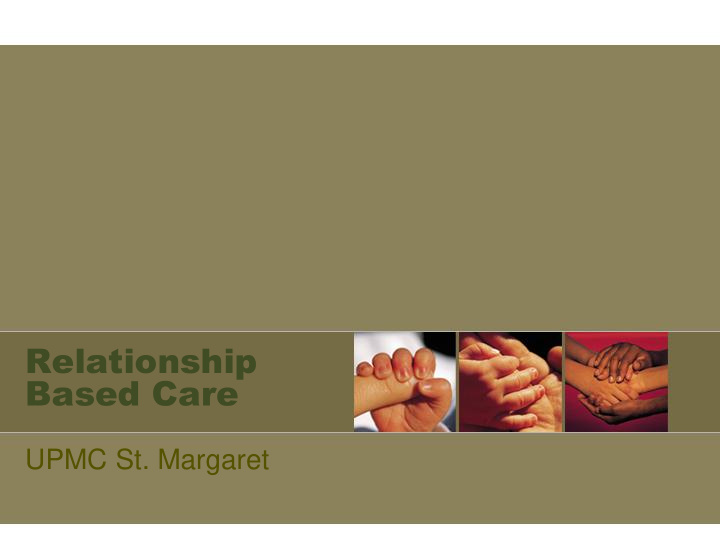



Relationship Based Care UPMC St. Margaret
Caring Theories • What is caring? • What does it look like in practice?
Jean Watson’s Caring Theory Description of Caring • A value and an attitude that has to become a will, an intention or a commitment that manifests itself in concrete acts.
Watson on Watson • Model entry can vary • Speaks about loving one’s work but not a job • In times of chaos- look to the core/foundation • Caritas factors: caring +love • Caritas goes beyond customer service • Rewarding to both patient and practitioner • Theory lives in the caring moment
Who is the person behind the patient? • Person • Patient • Body-physical • Machine
Key Concepts: Transpersonal Caring & the 10 Carative Factors • Humanistic – altruistic • Creative problem solving system of values caring process • Transpersonal teaching – • Faith – Hope learning • Supportive, protective and/or • Sensitivity to self and corrective mental, physical others societal & spiritual environment • Helping – trusting, human • Human needs assistance care relationship • Expressing positive and • Existential phenomenological negative feelings spiritual forces
Jean Watson’s Caring Theory Goal / Outcomes • To protect, enhance and preserve humanity by helping a person find meaning in illness, suffering, pain and existence.
Sharon Dingman’s The Caring Model™ • An Application model that builds upon the Caring Theories of Watson and Leininger • The Model as described by Dingman: – A way of doing the work we do everyday – A “back to basics” approach to care / service – A method for improving patient and employee satisfaction
The Caring Model™ Key Concepts • Introduce self to patients and explain your role in their care • Call the patient by his/her preferred name • Sit at the bedside for at least 5 minutes per shift to plan and review the patient’s care • Use touch, handshake or touch on the arm • Use the mission, vision and values statements in planning patient care
The Caring Model™ Considerations/Recommendations • A single institution study on the caring model identified the Caring Model as most significantly impacting 2 patient satisfaction attributes: – Anticipating needs – Responds to requests
Caring Theories in Action… • How would our care delivery be transformed here at SMH? • Story telling
Recommend
More recommend